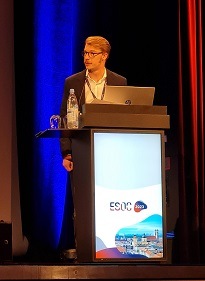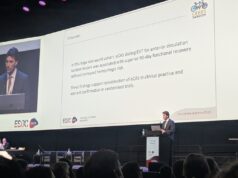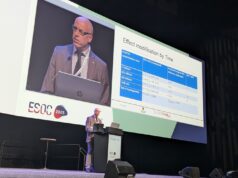
Supplying healthcare providers with performance feedback can significantly reduce the time between an ischaemic stroke patient arriving at a hospital and them subsequently receiving endovascular therapy (EVT), according to the findings of a clinical trial presented at last week’s European Stroke Organisation Conference (ESOC; 24–26 May, Munich, Germany).
Daniël Hansen (Erasmus University Medical Center, Rotterdam, The Netherlands), lead author of the study, who presented these findings at ESOC 2023, said: “This trial is the first methodologically rigorous approach to show that performance feedback in acute stroke care works. Ideally, such feedback should become part of daily practice.”
The randomised PERFEQTOS trial implemented performance feedback in 13 Dutch hospitals, step-by-step, and assessed its effect on time from arrival at the hospital to initiation of EVT—a period that is known to be critically important in the treatment of ischaemic stroke patients, owing to strong associations between time to reperfusion and functional outcomes.
Providing healthcare staff with performance feedback on process indicators may be an “attractive strategy” to improve the quality of stroke care, an ESO press release notes, but it can be challenging to study the effects of feedback here, as variation in outcomes between or within hospitals may also be explained by case-mix differences, stroke logistics, and time trends.
In his presentation, Hansen further noted that prior observational studies have demonstrated “substantial variability” in the effect estimates of performance feedback on stroke care quality.
The PERFEQTOS investigators assessed the extent to which performance feedback could reduce time from arrival at the hospital to initiation of EVT—dubbed ‘door-to-groin’ time—using a stepped-wedge cluster randomised trial design, and included a total of 13 Dutch hospitals providing EVT for ischaemic stroke. All of these hospitals started with a non-exposed period, after which clusters of 3–4 hospitals were randomised in steps of six months to cross from the control to the intervention group.
The intervention consisted of the installation of a local quality improvement team, including neurologists, neurointerventionists and nurses, that had access to a dashboard containing quality-of-care measures of its own hospital, benchmarked against the other participating hospitals for the same period as well as their own performance over time. Based on these measures, the dashboard recommended clearly if improvement was needed (yes or no).
In total, 4,747 EVT-treated acute stroke patients were included, of which 2,431 contributed to the intervention group and 2,316 to the control group. Performance feedback reduced the door-to-groin time by almost five minutes—with a median time of 52 minutes being observed in the control group versus 47 minutes in the intervention group. Hansen reported that this corresponds with a statistically significant time saving of more than 9%. Door-to-groin time data were “very complete” in PERFEQTOS, he added, with results only missing in 1.6% of patients.
The speaker did, however, relay minimal impacts of performance feedback on the trial’s secondary outcomes, with median door-to-groin times solely in patients who received intravenous thrombolysis (IVT); 24-hour National Institutes of Health stroke scale (NIHSS) scores; post-EVT expanded thrombolysis in cerebral infarction (eTICI) scores; and three-month modified Rankin scale (mRS) scores, all being similar between intervention and control.
Following this, Hansen ultimately concluded that—based on the statistically significant difference between the two groups regarding PERFEQTOS’ primary efficacy outcome—providing performance feedback through a local quality improvement team can reduce the time to EVT for patients with ischaemic stroke.












